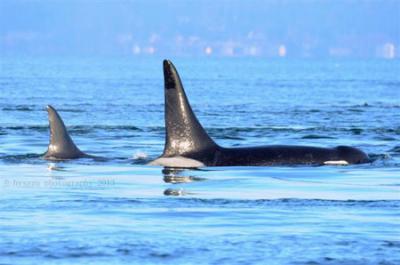
Orca Enigma

He was born in 1992, when his mother Olympia (L32) was about 37 years old. One three-year-old sibling died in 1981, long before he was born. By the age of six, he had lost two brothers as well: 11-year-old Scotia in 1995 and 24-year-old Leo in 1998. Mother Olympia died in 2005. Instead of traveling with his sister Spirit (L22), age 42, and her sole surviving son, 20-year-old Solstice (L89), he travels with elder matriarchs in other pods.
From 2005 to 2009, he accompanied matriarchs Lummi (K7) and Georgia (K11). At estimated lifespans of 98 years and 77 years respectively, they were the oldest females in K Pod at the time. Lummi died in 2008 and Georgia died in 2010.
By 2010, he was traveling regularly with J Pod, particularly with J Pod’s eldest females: Granny (J2), about 100, and Spieden (J8), about 80. That year, Granny lost her son Ruffles (J1). Ruffles lived to age 59, longer than any known Southern Resident male. The enigmatic orphan of whom I write seemed to swim into J1’s prodigious place of honor beside Granny and Spieden. He endured another loss when dear Spieden died in September.
So, who is this Elder Escort? He is perhaps the most intriguing male in the Southern Resident Community: Onyx (L87). I surmise that some indigenous societies have a word or phrase to describe L87’s distinguished role. In four decades of research on J, K, and L Pods, he is the only Southern Resident male observed to switch pods in this manner. Male offspring typically do not disperse from their natal pods.
Southern Resident killer whale culture is complex and sophisticated. Most researchers have only a rudimentary understanding of social dynamics in J, K, and L Pods. Unusual cases such as Onyx hint at boundless orca idiosyncrasies yet to be unraveled.
On December 26, a satellite tag was attached to the dorsal fin of our remarkable Southern Resident male, Onyx. Optimistically, since L87 hangs with J2, researchers may discover J Pod’s secret winter retreat. We know that K Pod and L Pod members travel as far as Central California in winter to search for Chinook salmon. J Pod’s whereabouts have been a mystery.
Pessimistically, data collected from the tag is meaningless if political inertia obstructs policy changes required to safeguard critical habitat for endangered Southern Residents. Moreover, Onyx is Granny’s close companion. Both orcas are recovering from Spieden’s death; they could be psychologically vulnerable. We cannot afford to lose a single Southern Resident to unintended consequences of invasive methodology. Losing exceptional Onyx would be intolerable.
Adult male Scoter (K25), age 22, was tagged in December 2012. His tag ceased transmitting in April, but it did not detach completely. Barbed darts remain embedded in his dorsal fin – an ugly symbol of desecration. Killer whales suffered centuries of abuse from misguided colonizers of the Northwest Coast. Now these imperiled orcas bear the high cost of rectifying the damage inflicted on them by humans. A potentially injurious sat tag shows researchers the degraded habitat where Southern Residents travel to find their depleted food source. Go figure.
Please support the non-invasive work of the Vashon Hydrophone Project (VHP): REPORT LOCAL WHALE SIGHTINGS ASAP TO 463-9041, as well as seal pups and sick, injured, or dead marine mammals on Island beaches. Prompt reports to the VHP expedite vital data collection efforts by Mark Sears and other researchers, and sustain an accurate record of whale sightings for Vashon-Maury initiated three decades ago. Send photos to Orca Annie at
Vashonorcas@aol.com.
- Login to post comments
